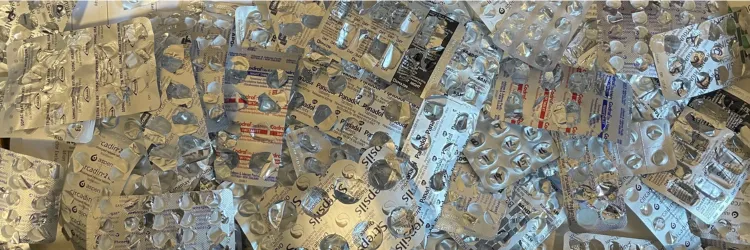Recycling Blister Packs

Did you watch the ABC’s War On Waste and despair at the thought of all of those blister packs going to landfill? We absolutely agree! They shouldn’t go to landfill, but they can’t go in your kerbside recycling bins – but nor should it be your duty as a consumer or citizen to work out what to do – the producers of these pesky materials need to take responsibility. But luckily there is action you can take and that’s to check out Pharmacycle!
When it comes to items that Australians wished they could recycle, blister packs are near the top the list. However, as blister packs are made of different materials, including plastic and aluminium, they cannot be recycled through kerbside recycling. This means that every year, hundreds of millions of blister packs are either sent to landfill or incorrectly placed into kerbside recycling, contaminating other materials streams.
But Pharmacycle lets you drop off empty medicinal blister packs at one of 200+ participating pharmacies across the country. And by using specialised recycling technology, located right here in Australia, Pharmacycle ensures that blister packs collected for recycling are actually recycled.
Pharmacycle manages all of the collection, logistics and processing of blister packs, providing full transparency and traceability and has partnerships with local manufacturers who use our recovered materials to substitute virgin resources.
WHAT HAPPENS?
Collected blister packs are transported to a processing facility located in Sydney. Each box or bag received at the processing facility is checked in and weighed allowing Pharmacycle to track and report on performance across their network of public drop off locations and participating organisations.
Once weights have been recorded, the contents of full boxes/bags are emptied onto a sorting table for a visual quality control check.
Any contamination, such as residual medication still in packaging, paperboard packaging, or non-accepted packaging is removed and managed accordingly (recycled where possible).
Any residual medication that is identified is removed and placed in a sealed container, which when full is sent to an appropriately licenced facility for disposal.
The empty blister packs are then put through a series of mechanical recycling processes to separate the aluminium foil/seal from the plastic blister. The steps include shredding, grinding, air-density separation, and finally electrostatic separation.
Once separated the aluminium and plastic material is kept in bulk bags until enough material is ready to be sent to end-users.
Pharmacycle has made it easy to get everyone involved in the correct disposal of used and empty medicinal blister packs.
Pharmacycle has introduced satchels and boxes, available to households. You can recycle used and empty blister packs from the convenience of your home using the Pharmacycle Recycle at Home Satchel which holds approximately 150 – 200 blister packs.
